Case Study
Transiberiana d’Italia
Contact name
Gianluca Di Lonardo
Institution name
Le Rotaie Molise
Region & country
Abruzzo and Molise Regions, Italy
Summary
The Sulmona-Carpinone-Isernia railway was an important link between the Adriatic and Tyrrhenian Sea. Born in 1897 and closed to passenger service in October 2011, “Le Rotaie Association” of Isernia worked to avoid final closure. After a trial phase, tourist journeys saved the railroad from definitive closure and brought over 30,000 travellers in 3 years, first by number of passengers in Italy. The “Transiberiana d’Italia” project became an example of tourism management for small countries and rail lover associations. The charm of the tourist experience has stimulated new interest and new perspectives for the territories involved. Unfortunately, train hire costs and poor cooperation with institutions are still a limit to the development.

Ancient railway in Abruzzo and Molise Region.
Photo by: Gianluca Di Lonardo

Transiberiana d’Italia
Photo by: Gianluca Di Lonardo
Background of the project
Railroad was closed to passenger transport, Italian Rails announced the intention to close the line in Castel di Sangro and reducing the kilometres until Abruzzo borders. Busses replaced trains for daily transportation, but busses were not frequent enough and the links between Sulmona and Isernia had great difficulties in the winter. Locals had to travel by car or leave the small towns in favour of the nearest cities.
The project needed a strong partnership with the institutions to reduce management costs and to improve contractual conditions for tourist trains workers. The project should grow and become a true business in such a way as to guarantee that the current volunteer work becomes a real job for those who want to remain in small villages. It needs a plan for transforming old stations into intermodal hubs and funding to stablish new local tourism businesses.
Solution and actions taken
After several institutional meetings with Abruzzo and Molise regions, there have been no news regarding partnerships.
“Le Rotaie” Association has improved management to reduce costs by increasing volunteer engagement.
A national law has transferred in 2017 rail tourism management to Italian regions.
“Le Rotaie” Association has increased relations with the municipalities interested to promote tourism.
No definitive solution to the issues at this time has yet been identified. Current partnership conditions do not guarantee the possibilities for further growth, there have been no structural interventions but only managerial improvements and new partnerships with Municipalities.
At the present time, “Le Rotaie” Association commits all ticket receipts to pay for management costs (including consumer goods, brochures, advertising and music bands) without profit.
- FS Foundation rents trains and on-board service, price can change according to the route.
- Municipalities of Campo di Giove, Pettorano sul Gizio, Roccaraso, Palena, Castel di Sangro, Pescocostanzo, Palena, San Pietro
- Avellana, Carovilli, Pescolanciano and Isernia offer free service for the reception of tourists.
- The Association “Pallenium Tourism” collaborates for tourist projects in the municipality of Palena and nearby areas.
Other institutions or parties involved
- FS Foundation
- Municipalities of Campo di Giove, Pettorano sul Gizio, Roccaraso, Palena, Castel di Sangro, Pescocostanzo, Palena, San Pietro Avellana, Carovilli, Pescolanciano and Isernia.
- Association “Pallenium Tourism”.
- New free collaborations for 2018 are being studied.
Results
In 2016, 26 trips were organized, more than twice the amount of trips during 2015.
30.000 passengers have used the service in 3 years of hard work, and the increase in the number of passengers has ensured constant trains, a trip every two weeks with a growing presence from abroad. Trains departing from Sulmona increased tourist overnights in hotels during the low season weekend and brought over 400 tourists for each day of travel. Currently the project covers the whole length of the railway, 140 km linear from Sulmona to Isernia.
Challenges
- Poor confidence in the project and little long-term tourist planning capacity are among the main problems encountered.
- At present it is not easy to find reliable partners for welcoming tourists, events in the countries are still not stimulating for tourism from outside the region while the train also fascinates foreigners.
Lessons learned
- The commitment of these three years has made it possible to understand the critical situation and project management costs.
- Thanks to the experience, today it is easier to evaluate the proposals and identify the difficulties. Some destinations, despite growing interest, are not beneficial to the economies of the “Le Rotaie”Association until new regional partnerships are established.
Contact name
Gianluca Di Lonardo
Institution name
Le Rotaie Molise
Website(s)
